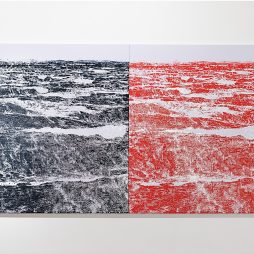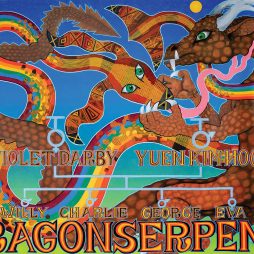REVIEW: A Tear in the Fabric
A Tear in the Fabric is the first project produced by 4A Centre for Contemporary Asian Art in Sydney for a regional partner. Developed with Bathurst Regional Art Gallery A Tear in the Fabric finds relevance and context in the rapidly changing demographics of the Central West and BRAG’s ongoing commitment to highlighting migrant histories.
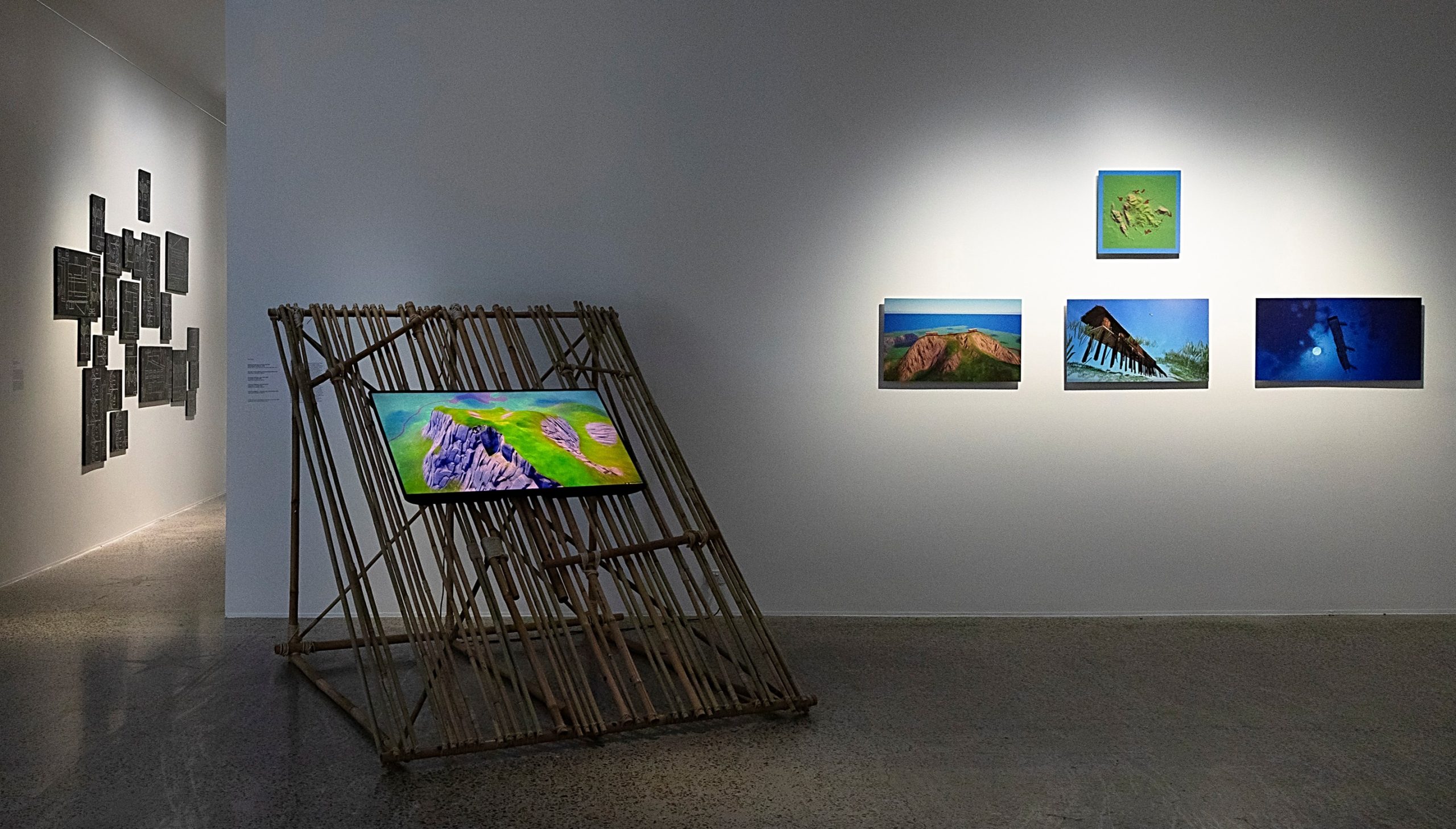
The curator Con Gerakaris’s considered arrangement of diverse works conjures the distinctive cultural and physical topographies of Asia. Entering A Tear in the Fabric, the viewer transits Leyla Stevens’s GROH GOH (Rehearsal for Rangda), 2023, a single channel video work depicting the mythological demon queen Rangda, a staple of Kecak. This genre of traditional Balinese theatre, customarily performed by men, is reconfigured by Stevens as a chorus of women. A brief appearance by the virtuoso Jro Mangku Serongga whose disciplined and refined gestures along with a sustained, paranormal outburst by extreme metal vocalist Karina Utomo that concludes GROH GOH, contrast strongly with the work’s improvisational qualities of informality, intimacy and sorority.
Once inside the main galleries the exhibition presents as a distinct acknowledgement of the way in which geography gives rise to cultures and how their transposition, including the ways forced and voluntary migration distorts and remakes them. On the left is Tiyan Baker’s Building A Longhouse At The Site Of The First Bukar Bidayǔh Settlement, 2025, an installation in which a video monitor affixed to a pitched bamboo slat is one of the many references to houses and temples that coheres A Tear in the Fabric curatorially and as a visitor experience. To its right are a series of related digital prints mounted on Dibond. The intentionality of the artist to comment on contested and often violent colonial histories was, I thought, problematised by the generalised rendering of the video game engine they employ in the production of the works.
Contributions by two other artists complete this half of the gallery. Visaya Hoffie’s 2025 Silent Series, a tetraptych or four panelled painting on felt, and three separate text pieces by Jenna Mayilema Lee. Although they differ conceptually and formally each artist engages with modes of sympathetic magic, alchemy and reclamation. Hoffie’s works utilise acoustic felt, sheet music notation and text. Hoffie is accessing their material histories and legacies in the practices of other more established artists, tethering them to the agency they are purported to have in art and life. Lee pulps old editions of the writings of New Zealand born publisher and author Alexander Wyclif Reed, reconstituting them as dilly bags. Furthermore, she overpaints upcycled book covers. Recuperation and transmutation are concurrently outcomes and processes in her works. These are well trodden paths and the works, although sophisticated in their realisation, reiterate rather than originate meaningfully fresh perspectives.
Behind the wall dividing the first of the two large galleries Gerakaris has positioned Allison Chhorn’s Disintegrate/Regenerate (‘Memory House’ Revisited), 2025. This work has an ethereal, architectonic presence that reinforces the links detectable in artworks elsewhere between specific building types and the fabrication of memory. Projected onto a suspended, fluttering fabric pavilion, Chhorn’s still and moving images remind us that the natural and human-made environments are more consciously entangled in Asia than they are here.
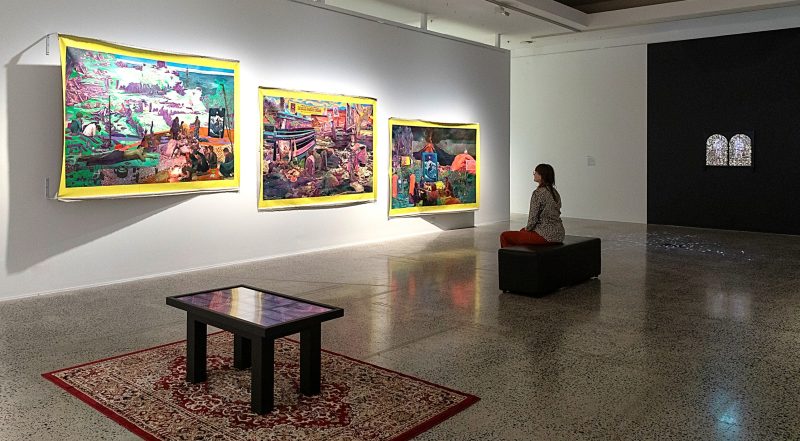
Installation view, ‘A Tear in the Fabric’, Bathurst Regional Art Gallery, 20 September – 9 November 2025, featuring (top left): Zico Albaiquni, In search of Lukis in the sense of What It Used to Be (Mencari Arah menuju pengertian lukis sedia kala) I-III, 2024, courtesy the artist and Amez Yavuz, Gadigal Sydney; (right) Ali Tahayori, Kill Me Softly, 2024, courtesy the artist and THIS IS NO FANTASY, Melbourne; (bottom left) Khaled Sabsabi, Tawla, 2011, courtesy the artist and Milani Gallery, Meanjin Brisbane. Photographed by Silversalt Photography.
The second of the two large galleries is also populated by assorted planar and spatial works across varied media. Interiority, as it pertains to private life and domestic spaces is beautifully articulated in Kill Me Softly, 2024 featuring a pair of hand cut mirrors embedded in vintage window frames by Ali Tahayori. Projected onto yet seemingly within them, is a looped video of Tahayori and an ex-partner embracing. The mirror’s fractal reflection on the floor enacts the forced separation of the public and private self in the lives of queer people in Iran, the artist’s birthplace.
Opposite each other are the works of Zico Albaiquni and Hirofumi Uchino from Indonesia and Japan respectively. These two artists’ works are similarly warped and suspended geomatic, rectangular shapes, echoing each other morphologically while alluding to the importance of distortion in their works and the curator’s premise. Layering one thing over another is an important strategy in the works of these artists. Albaiquni overpaints chromatic giclee prints on canvas with intensely saturated oil paint and Uchino stratifies soundscapes recorded on and captured within a suite of metal sheets. The synchronicity and dialogue between these two presentations elevates what is a very successful opticality that makes this large room more compelling than the other.
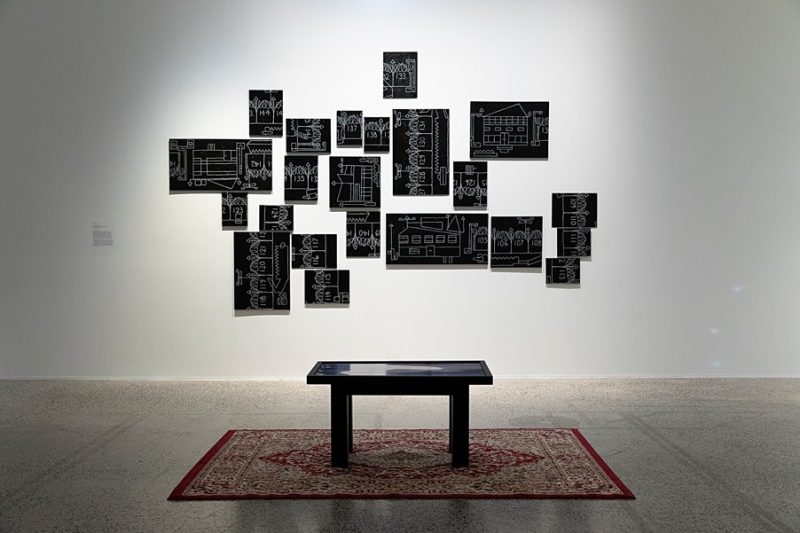
Installation view, A Tear in the Fabric, Bathurst Regional Art Gallery, 20 September – 9 November 2025, featuring Khaled Sabsabi, South @ Part B, 2017; and Khaled Sabsabi, Tawla, 2011. Art works courtesy the artist and Milani Gallery, Meanjin Brisbane. Photographed by Silversalt Photography.
The final works, those of Khaled Sabsabi, elide the two galleries, concurrently looping and concluding the show. South @ Part B, 2017-19, reads simultaneously as a kind of lesson because of chalklike quality of the marks on small, aggregated blackboards and cleft blocks of housing. Tawala, 2011, is a twelve-minute video in which the backwards and forwards gestures of the hands of backgammon players strongly suggest the movements of a weaving shuttle in the creation of fabric.
I return to the exhibition title and the two meanings of Tear —a homograph connoting “to rend with force” and “the drop of liquid that falls from our eye.” This latent ambiguity has a potential for the poetic that is occasionally absent from some of the works and abundant in others.
Exhibition
A Tear in the Fabric
20 September – 9 November 2025
Bathurst Regional Art Gallery, NSW
Images courtesy of the artists; Bathurst Regional Art Gallery, NSW; 4A Centre for Contemporary Asian Art, Sydney; and Silversalt Photography
Gary Carsley lives and works on Wiradyuri Country where he colludes with Renjie Teoh in the artHITects and establishes a modest garden.





